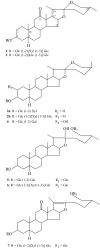Anti-inflammatory and anti-arthritic effects of Yucca schidigera: a review
- PMID: 16571135
- PMCID: PMC1440857
- DOI: 10.1186/1476-9255-3-6
Anti-inflammatory and anti-arthritic effects of Yucca schidigera: a review
Abstract
Yucca schidigera is a medicinal plant native to Mexico. According to folk medicine, yucca extracts have anti-arthritic and anti-inflammatory effects. The plant contains several physiologically active phytochemicals. It is a rich source of steroidal saponins, and is used commercially as a saponin source. Saponins have diverse biological effects, including anti-protozoal activity. It has been postulated that saponins may have anti-arthritic properties by suppressing intestinal protozoa which may have a role in joint inflammation. Yucca is also a rich source of polyphenolics, including resveratrol and a number of other stilbenes (yuccaols A, B, C, D and E). These phenolics have anti-inflammatory activity. They are inhibitors of the nuclear transcription factor NFkappaB. NFkB stimulates synthesis of inducible nitric oxide synthase (iNOS), which causes formation of the inflammatory agent nitric oxide. Yucca phenolics are also anti-oxidants and free-radical scavengers, which may aid in suppressing reactive oxygen species that stimulate inflammatory responses. Based on these findings, further studies on the anti-arthritic effects of Yucca schidigera are warranted.
Figures




Similar articles
-
Relative effects of phenolic constituents from Yucca schidigera Roezl. bark on Kaposi's sarcoma cell proliferation, migration, and PAF synthesis.Biochem Pharmacol. 2006 May 14;71(10):1479-87. doi: 10.1016/j.bcp.2006.01.021. Epub 2006 Mar 6. Biochem Pharmacol. 2006. PMID: 16580641
-
Inhibition of inducible nitric oxide synthase expression by yuccaol C from Yucca schidigera roezl.Life Sci. 2004 Aug 6;75(12):1491-501. doi: 10.1016/j.lfs.2004.03.013. Life Sci. 2004. PMID: 15240183
-
Inhibition of blood platelet adhesion and secretion by different phenolics from Yucca schidigera Roezl. bark.Nutrition. 2005 Feb;21(2):199-206. doi: 10.1016/j.nut.2004.03.024. Nutrition. 2005. PMID: 15723749
-
Yucca schidigera Usage for Healthy Aquatic Animals: Potential Roles for Sustainability.Animals (Basel). 2021 Jan 6;11(1):93. doi: 10.3390/ani11010093. Animals (Basel). 2021. PMID: 33419069 Free PMC article. Review.
-
Structure, Bioactivity and Analytical Methods for the Determination of Yucca Saponins.Molecules. 2021 Aug 30;26(17):5251. doi: 10.3390/molecules26175251. Molecules. 2021. PMID: 34500685 Free PMC article. Review.
Cited by
-
Green tea and exercise interventions as nondrug remedies in geriatric patients with rheumatoid arthritis.J Phys Ther Sci. 2016 Oct;28(10):2820-2829. doi: 10.1589/jpts.28.2820. Epub 2016 Oct 28. J Phys Ther Sci. 2016. PMID: 27821943 Free PMC article.
-
Effects of Dietary Inclusion of a Proprietary Combination of Quillaja saponaria and Yucca schidigera on Intestinal Permeability and Immune Response in Broiler Chickens during a Coccidia Challenge.Animals (Basel). 2024 Jun 8;14(12):1737. doi: 10.3390/ani14121737. Animals (Basel). 2024. PMID: 38929356 Free PMC article.
-
Yucca schidigera can mitigate ammonia emissions from manure and promote poultry health and production.Environ Sci Pollut Res Int. 2018 Dec;25(35):35027-35033. doi: 10.1007/s11356-018-3546-1. Epub 2018 Oct 27. Environ Sci Pollut Res Int. 2018. PMID: 30368697
-
Effects of Supplementing Finishing Goats with Mitragyna speciosa (Korth) Havil Leaves Powder on Growth Performance, Hematological Parameters, Carcass Composition, and Meat Quality.Animals (Basel). 2022 Jun 26;12(13):1637. doi: 10.3390/ani12131637. Animals (Basel). 2022. PMID: 35804536 Free PMC article.
-
Enhancement of protective vaccine-induced antibody titer to swine diseases and growth performance by Amino-Zn, yucca extract, and β-mannanase feed additive in wean-finishing pigs.Front Vet Sci. 2023 Aug 15;10:1095877. doi: 10.3389/fvets.2023.1095877. eCollection 2023. Front Vet Sci. 2023. PMID: 37662989 Free PMC article.
References
-
- Cheeke PR, Otero R. Yucca, quillaja may have role in animal nutrition. Feedstuffs. 2005. pp. 11–14.http://www.feedstuffs.com/ME2/Default.asp
-
- Cheeke PR. Natural Toxicants in Feeds, Forages and Poisonous Plants. Upper Saddle River, NJ: Prentice-Hall; 1998.
-
- Lindhal IL, Shalkop WT, Dougherty RW, Thompson CR, Van Atta GR, Bickoff EM, Walter ED, Livingston AG, Guggolz J, Wilson RH, Sideman MB, DeEds F. USDA Technical Bulletin No 1161. Washington, D.C; 1957. Alfalfa saponins: Studies on their chemical, pharmacological and physiological properties in relation to ruminant bloat.
-
- Oakenfull D, Sidhu GS. Saponins. In: Cheeke PR, editor. Toxicants of Plant Origin. Vol. 2. Boca Raton, Fla: CRC Press; 1989. pp. 97–141.
-
- Newman HA, Kummerow FA, Scott HH. Dietary saponin, a factor which may reduce liver and serum cholesterol levels. Poult Sci. 1957;37:42–46.
LinkOut - more resources
Full Text Sources
Other Literature Sources

